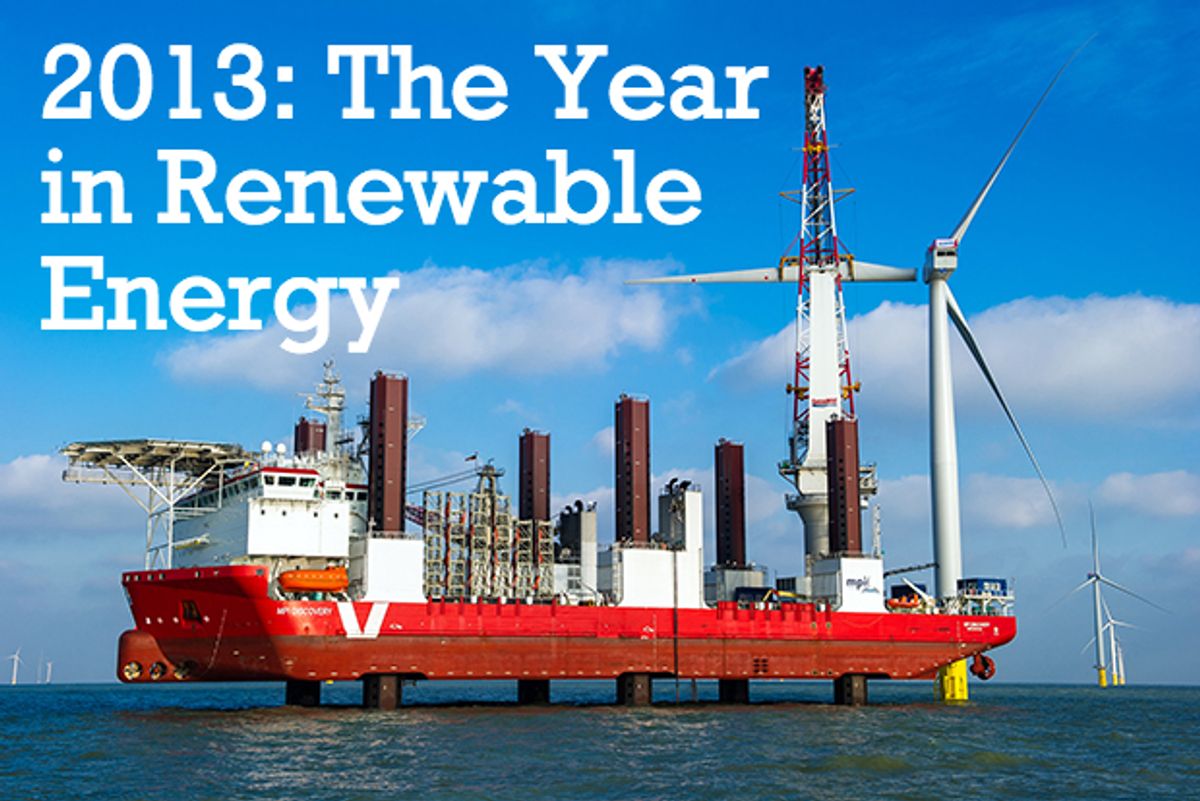Looking back is substantially easier than predicting the future. One year ago, I wrote the following: "This time, though, I am more confident: in 2013 the first offshore turbine in U.S. waters will start spinning. (Probably.)"
I wasn't wrong! (Technically.) In June, a modest 20-meter-tall (65-foot) floating turbine began feeding power to the grid from a harbor in Maine. It wasn't much, and the big offshore wind farms all gunning for first place remain tied up in pre-construction quagmires, but it was a turbine, and it was offshore. Cause for celebration! And more generally, offshore wind does appear poised to actually make a leap; early efforts by Cape Wind in Nantucket Sound suggest that long-cursed project may qualify for a tax credit based on construction starting by the end of this year. And a number of other big wind farms, particularly off the coasts of Rhode Island, New Jersey, and Virginia, may soon get under way. In spite of the positive signs for the industry, though, I have learned my lesson: I will make no promises of spinning offshore turbines in 2014. We'll just have to wait and see.
Back onshore, 2013 was marked by a steady march toward practical, utility-scale energy storage, as well as a series of short-lived record setters in solar and wind generation. One after another, big concentrating solar thermal plants claimed largest-in-the-world status: Abu Dhabi's Shams 1, Arizona's Solana (more on that one in a moment), and finally California's Ivanpah plant. CSP has been considered the most viable way to bet big on solar—and these 100-plus-megawatt plants seem to back that up—but the ever-dropping prices on photovoltaics has slowed some of CSP's momentum, and perhaps delayed some of the grandest of desert solar plans.
Wind also went big this year, with the United Kingdom's London Array switching on to become the world's biggest offshore wind farm, beating out the Irish Walney site. Big wind plans abound, both on and offshore, though the London Array's full gigawatt capacity may be tough to beat any time soon.
But generating all this clean solar and wind energy is only one aspect of renewable power. Intermittency and dispatchability have long plagued efforts to scale renewables, and 2013 was the year that energy storage really began to take the spotlight. California now has the country's first energy storage mandate, a law requiring storage capacity that can output 1325 megawatts by the end of 2020, and 200 MW by 2015. How the state will achieve this is currently up in the air, but they should have several options: it seemed that the year was full of news on new approaches to storing power.
At the Advanced Research Projects Agency—Energy summit in February, storage projects dominated the exhibit hall floor. Ideas ranged from improved flywheels to iron-flow batteries, but more established approaches are likely to win out for the foreseeable future: improved lithium-ion batteries and old ideas like compressed air energy storage. Several compressed air companies are starting to actually ship units (or will soon start) that can help wind farms max out on their capacity. In the U.K., a largest-yet pilot project will test a huge Li-ion battery installation in Bedfordshire.
And power plants are starting to include storage from the outset as well. That Solana plant in Arizona, built by Abengoa Solar, incorporates molten salt storage that lets the plant produce power for six hours after the sun goes down.
All of this sounds like great news for renewables, and it is. But when facing the magnitude of the climate change challenge, a few gigawatts here or there aren't remotely enough. A report from the International Energy Agency laid out the problem in a nutshell: the overall share of energy attributable to coal, oil, and gas today has not changed one smidge from the late 1980s. Renewables will need to grow at a staggering pace in order to make a significant difference in emissions.
We'll check back next year to see how the effort is going.
Dave Levitan is the science writer for FactCheck.org, where he investigates the false and misleading claims about science that U.S. politicians occasionally make.



